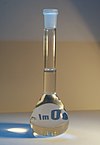Isopropyl alcohol
| |||

| |||
| Names | |||
|---|---|---|---|
| Preferred IUPAC name
Propan-2-ol[2] | |||
| Other names | |||
| Identifiers | |||
3D model (
JSmol ) |
|||
| 635639 | |||
| ChEBI | |||
| ChEMBL | |||
| ChemSpider | |||
ECHA InfoCard
|
100.000.601 | ||
| 1464 | |||
| KEGG | |||
PubChem CID
|
|||
RTECS number
|
| ||
| UNII | |||
| UN number | 1219 | ||
CompTox Dashboard (EPA)
|
|||
| |||
| |||
| Properties | |||
| C3H8O | |||
| Molar mass | 60.096 g/mol | ||
| Appearance | Colorless liquid | ||
| Odor | Pungent alcoholic odor | ||
| Density | 0.786 g/cm3 (20 °C) | ||
| Melting point | −89 °C (−128 °F; 184 K) | ||
| Boiling point | 82.6 °C (180.7 °F; 355.8 K) | ||
Miscible with water
| |||
| Solubility | Miscible with benzene, chloroform, ethanol, diethyl ether, glycerol; soluble in acetone | ||
| log P | −0.16[3] | ||
| Acidity (pKa) | 16.5[4] | ||
| −45.794·10−6 cm3/mol | |||
Refractive index (nD)
|
1.3776 | ||
| Viscosity | 2.86 cP at 15 °C 1.96 cP at 25 °C[5] 1.77 cP at 30 °C[5] | ||
| 1.66 D (gas) | |||
| Pharmacology | |||
| D08AX05 (WHO) | |||
| Hazards | |||
| Occupational safety and health (OHS/OSH): | |||
Main hazards
|
Flammable, mildly toxic[6] | ||
| GHS labelling: | |||
 
| |||
| Danger | |||
| H225, H302, H319, H336 | |||
| P210, P261, P305+P351+P338 | |||
| NFPA 704 (fire diamond) | |||
| Flash point | Open cup: 11.7 °C (53.1 °F; 284.8 K) Closed cup: 13 °C (55 °F) | ||
| 399 °C (750 °F; 672 K) | |||
Explosive limits
|
2–12.7% | ||
Threshold limit value (TLV)
|
980 mg/m3 (TWA), 1225 mg/m3 (STEL) | ||
| Lethal dose or concentration (LD, LC): | |||
LD50 (median dose)
|
|||
LC50 (median concentration)
|
| ||
LCLo (lowest published)
|
| ||
| NIOSH (US health exposure limits): | |||
PEL (Permissible)
|
TWA 400 ppm (980 mg/m3)[7] | ||
REL (Recommended)
|
TWA 400 ppm (980 mg/m3), ST 500 ppm (1225 mg/m3)[7] | ||
IDLH (Immediate danger) |
2000 ppm[7] | ||
| Safety data sheet (SDS) | [1] | ||
| Related compounds | |||
Related alcohols
|
2-butanol
| ||
| Supplementary data page | |||
| Isopropyl alcohol (data page) | |||
Except where otherwise noted, data are given for materials in their standard state (at 25 °C [77 °F], 100 kPa).
| |||
Isopropyl alcohol (
Isopropyl alcohol, an organic
It was first synthesized in 1853 by
Properties
Isopropyl alcohol is
Isopropyl alcohol forms an azeotrope with water, which gives a boiling point of 80.37 °C (176.67 °F) and a composition of 87.7% by mass (91% by volume) isopropyl alcohol. It has a slightly bitter taste, and is not safe to drink.[11][12]
Isopropyl alcohol becomes increasingly viscous with decreasing temperature and freezes at −89.5 °C (−129.1 °F).[9] Mixtures with water have higher freezing points: 99% at −89.5 °C (−129.1 °F), 91% (the azeotrope) at −75.5 °C (−103.9 °F), and 70% at −61.7 °C (−79.1 °F).[13]
Isopropyl alcohol has a maximal absorbance at 205 nm in an ultraviolet-visible spectrum.[14][15]
Reactions
Isopropyl alcohol can be
- (CH3)2CHOH → (CH3)2CO + H2
Isopropyl alcohol is often used as both solvent and
Like most alcohols, isopropyl alcohol reacts with active metals such as potassium to form alkoxides that are called isopropoxides. With titanium tetrachloride, isopropyl alcohol reacts to give titanium isopropoxide:
- TiCl4 + 4 (CH3)2CHOH → Ti(OCH(CH3)2)4 + 4 HCl
This and similar reactions are often conducted in the presence of base.
The reaction with aluminium is initiated by a trace of mercury to give aluminium isopropoxide.[16]
History
Isopropyl alcohol was first synthesized by the chemist Alexander William Williamson in 1853. He achieved this by heating a mixture of propene and sulfuric acid.
Production
In 1994, 1.5 million tonnes of isopropyl alcohol were produced in the United States, Europe, and Japan.[18] It is primarily produced by combining water and
There are two routes for the hydration process and both processes require that the isopropyl alcohol be separated from water and other by-products by distillation. Isopropyl alcohol and water form an azeotrope, and simple distillation gives a material that is 87.9% by mass isopropyl alcohol and 12.1% by mass water.[20] Pure (anhydrous) isopropyl alcohol is made by azeotropic distillation of the wet isopropyl alcohol using either diisopropyl ether or cyclohexane as azeotroping agents.[18]Biological
Small amounts of isopropyl alcohol are produced in the body in diabetic ketoacidosis.[21]
Indirect hydration
Indirect hydration reacts propene with sulfuric acid to form a mixture of sulfate esters. This process can use low-quality propene, and is predominant in the USA. These processes give primarily isopropyl alcohol rather than 1-propanol, because adding water or sulfuric acid to propene follows Markovnikov's rule. Subsequent hydrolysis of these esters by steam produces isopropyl alcohol, by distillation. Diisopropyl ether is a significant by-product of this process; it is recycled back to the process and hydrolyzed to give the desired product.[18]
- CH3CH=CH2 + H2O (CH3)2CHOH
Direct hydration
Direct hydration reacts propene and water, either in gas or liquid
Hydrogenation of acetone
Isopropyl alcohol can be prepared via the hydrogenation of acetone; however, this approach involves an extra step compared to the above methods, as acetone is itself normally prepared from propene via the cumene process.[18] IPA cost is primarily driven by raw material (acetone or propylene) cost. A known issue is the formation of MIBK and other self-condensation products. Raney nickel was one of the original industrial catalysts, modern catalysts are often supported bimetallic materials.
Uses
In 1990, 45,000 metric tonnes of isopropyl alcohol were used in the United States, mostly as a solvent for coatings or for industrial processes. In that year, 5400 metric tonnes were used for household purposes and in personal care products. Isopropyl alcohol is popular in particular for pharmaceutical applications,[18] due to its low toxicity. Some isopropyl alcohol is used as a chemical intermediate. Isopropyl alcohol may be converted to acetone, but the cumene process is more significant.[18]
Solvent
Isopropyl alcohol dissolves a wide range of
Isopropyl alcohol is commonly used for cleaning
packages.Intermediate
Isopropyl alcohol is
Medical
Inhaled isopropyl alcohol can be used for treating nausea in some settings by placing a disinfecting pad under the nose.[27]
Early uses as an anesthetic
Although isopropyl alcohol can be used for anesthesia, its many negative attributes or drawbacks prohibit this use. Isopropyl alcohol can also be used similarly to ether as a solvent[28] or as an anesthetic by inhaling the fumes or orally. Early uses included using the solvent as general anesthetic for small mammals[29] and rodents by scientists and some veterinarians. However, it was soon discontinued, as many complications arose, including respiratory irritation, internal bleeding, and visual and hearing problems. In rare cases, respiratory failure leading to death in animals was observed.
Automotive
Isopropyl alcohol is a major ingredient in "gas dryer"
Laboratory
As a biological specimen preservative, isopropyl alcohol provides a comparatively non-toxic alternative to formaldehyde and other synthetic preservatives. Isopropyl alcohol solutions of 70–99% are used to preserve specimens.
Isopropyl alcohol is often used in DNA extraction. A lab worker adds it to a DNA solution to precipitate the DNA, which then forms a pellet after centrifugation. This is possible because DNA is insoluble in isopropyl alcohol.
Semiconductors
Isopropyl alcohol is used as an additive in alkaline anisotropic etching of monocrystalline silicon, such as with potassium hydroxide or tetramethylammonium hydroxide. This process is used in texturing of silicon solar cells and microfabrication (e.g. in MEMS devices). Isopropyl alcohol increases the anisotropy of the etch by increasing the etch rate of [100] plane relative to higher indexed planes.[30]
Safety
Isopropyl alcohol vapor is denser than air and is
Toxicology
Isopropyl alcohol, via its metabolites, is somewhat more toxic than ethanol, but considerably less toxic than
Isopropyl alcohol is oxidized to form acetone by alcohol dehydrogenase in the liver[35] and has a biological half-life in humans between 2.5 and 8.0 hours.[35] Unlike methanol or ethylene glycol poisoning, the metabolites of isopropyl alcohol are considerably less toxic, and treatment is largely supportive. Furthermore, there is no indication for the use of fomepizole, an alcohol dehydrogenase inhibitor, unless co-ingestion with methanol or ethylene glycol is suspected.[38]
In forensic pathology, people who have died as a result of diabetic ketoacidosis usually have blood concentrations of isopropyl alcohol of tens of mg/dL, while those by fatal isopropyl alcohol ingestion usually have blood concentrations of hundreds of mg/dL.[21]
References
- ^ "Alcohols Rule C-201.1". Nomenclature of Organic Chemistry (The IUPAC 'Blue Book'), Sections A, B, C, D, E, F, and H. Oxford: Pergamon Press. 1979.
Designations such as isopropanol, sec-butanol, and tert-butanol are incorrect because there are no hydrocarbons isopropane, sec-butane, and tert-butane to which the suffix "-ol" can be added; such names should be abandoned. Isopropyl alcohol, sec-butyl alcohol, and tert-butyl alcohol are, however, permissible (see Rule C-201.3) because the radicals isopropyl, sec-butyl, and tert-butyl do exist.
- ISBN 978-0-85404-182-4.
- ^ "Isopropanol_msds". chemsrc.com. Archived from the original on 10 March 2020. Retrieved 4 May 2018.
- doi:10.1139/v79-444.
- ^ ISBN 978-0-07-073401-2.
- ^ Isopropyl alcohol toxicity
- ^ a b c NIOSH Pocket Guide to Chemical Hazards. "#0359". National Institute for Occupational Safety and Health (NIOSH).
- ^ a b c d "Isopropyl alcohol". Immediately Dangerous to Life or Health Concentrations (IDLH). National Institute for Occupational Safety and Health (NIOSH).
- ^ a b "Isopropanol". PubChem. Archived from the original on 12 February 2019. Retrieved 10 February 2019.
- ^ Doolittle, Arthur K. (1954). The Technology of Solvents and Plasticizers. New York: John Wiley & Sons, Inc. p. 628.
- ^ ISBN 9780911910278.
- ISBN 978-0-471-41961-7.
- ^ "What is the Freezing Point of Isopropyl Alcohol?". Retrieved 18 December 2023.
- ^ "Isopropyl Alcohol, , Suitable for Liquid Chromatography, Extract/, UV-Spectrophotometry". VWR International. Archived from the original on 31 March 2016. Retrieved 25 August 2014.
- ^ "UV Cutoff" (PDF). University of Toronto. Archived (PDF) from the original on 8 October 2013. Retrieved 25 August 2014.
- ISBN 0471936235.
- ISBN 978-3-527-30289-5.
- ^ ISBN 978-3527306732.
- ISBN 978-0471238966.
- ^ CRC Handbook of Chemistry and Physics, 44th ed. pp. 2143–2184.
- ^ S2CID 21101240.
- ^ Directo-Meston, Danielle (9 February 2021). "How to Properly Clean Your Bong, According to Cannabis Experts". Rolling Stone. Retrieved 31 March 2024.
- ^ Intel application method arcticsilver.com
- ^ "Sodium Isopropyl Xanthate, SIPX, Xanthate". 3DChem.com. Archived from the original on 4 May 2012. Retrieved 17 June 2012.
- ^ "Guide to Local Production: WHO-recommended Handrub Formulations" (PDF). World Health Organization. August 2009. Archived (PDF) from the original on 19 May 2009. Retrieved 5 October 2020.
- ^ Otitis Externa (Swimmers Ear). Medical College of Wisconsin.
- PMID 30108075.
- PMID 20285822.
- ^ Society for Experimental Biology and Medicine (1922). Proceedings of the Society for Experimental Biology and Medicine, Volume 19. p. 85. Archived from the original on 20 December 2021. Retrieved 24 September 2016.
- ISSN 0924-4247.
- ^ "Isopropanol". Sigma-Aldrich. 19 January 2012. Archived from the original on 17 January 2021. Retrieved 6 July 2012.
- .
- ^ "Chemical safety: peroxide formation in 2-propanol". Chemical & Engineering News. 94 (31): 2. 1 August 2016. Archived from the original on 7 November 2017. Retrieved 2 November 2017.
- ^ "Hazardous Substance Fact Sheet" (PDF). Official Site of The State of New Jersey. Retrieved 4 November 2023.
- ^ S2CID 30223646.
- PMID 34905533.
- PMID 12726989.
- ^ "Isopropyl alcohol poisoning". uptodate.com. Archived from the original on 10 October 2017. Retrieved 10 October 2017.
External links
- CDC – NIOSH Pocket Guide to Chemical Hazards - Isopropyl alcohol
- Environmental Health Criteria 103: 2-Propanol



